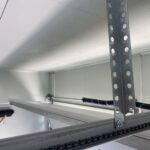If you have a really heavy door, particularly a door that is “top heavy” (a door that feels heaviest near the floor, often due to oversized windows), an opener rail support is a huge factor in how well it operates.
In fact, it is probably more important than the horsepower of your opener. It doesn’t matter how strong the motor is, if the rail flexes as the door lifts off it puts extra strain on the entire system. It is pretty much unheard of for the actual electric motor to be a point of failure, usually its a gear, bearing, pulley, etc.
On Linear garage door openers, the “T” shaped rail has punchouts along the top edge where an additional support can easily be attached using the typical garage door “track bolt”. There will be plenty of room for the trolley and carriage to pass by without getting caught. Just like this:


LiftMaster opener rails can be drilled to attach an additional support, but it is tough. You will probably burn up a bit or two and spend about 20 minutes drilling. More frequently, a second “T” rail is “married” to the original rail, and there is a special bracket to attach your support. It is kind of expensive and a pain in the neck, but it works. If you really want a LiftMaster opener it is your only option.
Modern Chamberlain and Craftsman openers use a square tube rail that the trolley and carriage wrap around. It is not possible to install an additional support. If your door is really heavy, the 1.25 horsepower options from Chamberlain/Craftsman aren’t going to be any better than a 3/4 Linear with support added.
Genie openers now have a very flimsy rail and I would not recommend any of their products for any door, much less a really heavy one. The old Genie Screwdrive models can be drilled to attach an additional support if needed. It may work on the new rail design, but it will require putting a hole in the top of the rail which may interfere with trolley. I have not tried it as I avoid Genie openers like the plague.
Does my opener require an extra rail support?
The need for an additional rails support comes from the felt weight of the garage door that is being lifted. These are the most common types of doors that need it:
- Wood “Carriage” style doors
- Steel “Carriage” style doors with large windows
- Insulated steel doors with insulated windows
- Any decorative door with sections taller than 21″